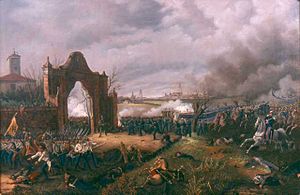
Back حرب الاستقلال الإيطالية الأولى Arabic Avstriya-İtaliya müharibəsi Azerbaijani اوتریش-ایتالیا ساواشی AZB Primera guerra d'independència italiana Catalan První italská válka za nezávislost Czech Første Italienske Uafhængighedskrig Danish Erster italienischer Unabhängigkeitskrieg German Πρώτος Ιταλικός Πόλεμος της Ανεξαρτησίας Greek Primera guerra de independencia italiana Spanish نخستین جنگ استقلال ایتالیا Persian
| First Italian War of Independence | |||||||||
|---|---|---|---|---|---|---|---|---|---|
| Part of the Revolutions of 1848 and Unification of Italy | |||||||||
 The Battle of Novara (1849) | |||||||||
| |||||||||
| Belligerents | |||||||||
| Supported by: | (1849) | ||||||||
| Commanders and leaders | |||||||||
|
|
| ||||||||
| Strength | |||||||||
| |||||||||
| Casualties and losses | |||||||||
|
| ||||||||
The First Italian War of Independence (Italian: Prima guerra d'indipendenza italiana), part of the Italian Unification (Risorgimento), was fought by the Kingdom of Sardinia (Piedmont) and Italian volunteers against the Austrian Empire and other conservative states from 23 March 1848 to 22 August 1849 in the Italian Peninsula.
The conflict was preceded by the outbreak of the Sicilian Revolution of 1848 against the House of Bourbon-Two Sicilies. It was precipitated by riots in the cities of Milan (Five Days) and Venice, which rebelled against Austria and established their own governments.
The part of the conflict which was fought by King Charles Albert against Austria in northern Italy was a royal war and consisted of two campaigns. In both campaigns, the Kingdom of Sardinia attacked the Austrian Empire and after initial victories, Sardinia was decisively defeated and so lost the war. The decisive events of the first and second campaigns were the Battles of Custoza and Novara respectively.
At the beginning of the royal war, the Kingdom of Sardinia was supported by the Papal States and the Kingdom of the Two Sicilies, which withdrew after they had barely participated in any of the fighting. However, volunteers from the Papal and the Neapolitan armies joined the other Italian volunteers and fought against Austria.
Besides the royal war, revolutionary movements took place in various Italian states (Papal States, Tuscany, etc.), part of the Revolutions of 1848 in the Italian states, which could not be reconciled with the liberal ideals of Piedmont. Historiography treats those revolutions and the Sicilian Revolution of 23 March 1848 as a popular war. It also failed, ended in the restoration of traditional institutions and forced many rebels into exile.[4][5]
In the popular war with the internal revolutionaries, the Kingdom of Two Sicilies and the Papal States found themselves on the side opposite to the one on which they had been on during the royal war, when they had initially supported Piedmont.
The popular war gave prominence to the military commander Giuseppe Garibaldi, but he was defeated, as was King Charles Albert, who abdicated at the end of the war in favour of his eldest son, King Victor Emmanuel II.
- ^ "Siege of Rome | Summary | Britannica".
- ^ Dwight, Theodore (1895). The Roman Republic of 1849: With Accounts of the Inquisition, and the Siege of Rome, And Biographical Sketches. p. 18.
- ^ a b Clodfelter, Micheal (2017). Warfare and Armed Conflicts: A Statistical Reference to Casualty and Other Figures, 1500–2000 (4th ed.). p. 178.
- ^ Langer, William K. (1969). Political and Social Upheaval, 1832–1852. New York, Harper & Row. pp. 371–386.
- ^ Robertson, Priscilla (1952). Revolutions of 1848: a social history. Princeton, Princeton University Press. pp. 309–401.
© MMXXIII Rich X Search. We shall prevail. All rights reserved. Rich X Search